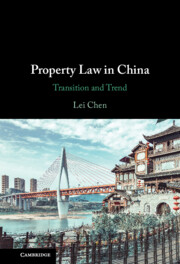
- Publisher:
- Cambridge University Press
- Online publication date:
- July 2025
- Print publication year:
- 2025
- Online ISBN:
- 9781009194112
- Subjects:
- Socio-Legal Studies, Law, Property Law
We use cookies to distinguish you from other users and to provide you with a better experience on our websites. Close this message to accept cookies or find out how to manage your cookie settings.

Unlock the intricacies of Chinese property law with this groundbreaking book, perfect for legal practitioners, scholars, and international investors. This comprehensive guide delves into the complexities of Chinese property law, offering detailed analysis, practical case studies, and insightful global comparisons. Understand the evolution and current landscape of property law in China, and see how theoretical principles are applied in real-world scenarios. Whether you're navigating cross-border property issues, developing legal strategies, or seeking an academic resource, this book is an invaluable tool. Authored by a recognized expert, it combines scholarly rigor with practical expertise, making it an essential addition to your legal library.
‘Unlock the intricacies of Chinese property law with this groundbreaking book, perfect for legal practitioners, scholars and international investors. This comprehensive guide delves into the complexities of Chinese property law, offering detailed analysis, practical case studies and insightful global comparisons. Understand the evolution and current landscape of property law in China and see how theoretical principles are applied in real-world scenarios. Whether you’re navigating cross-border property issues, developing legal strategies or seeking an academic resource, this book is an invaluable tool. Authored by a recognised expert, it combines scholarly rigour with practical expertise, making it an essential addition to your legal library.’
Lei Chen - Ph.D., Chair in International Arbitration and Chinese Law at Durham University
To save content items to your account, please confirm that you agree to abide by our usage policies. If this is the first time you use this feature, you will be asked to authorise Cambridge Core to connect with your account. Find out more about saving content to .
To save content items to your Kindle, first ensure no-reply@cambridge.org is added to your Approved Personal Document E-mail List under your Personal Document Settings on the Manage Your Content and Devices page of your Amazon account. Then enter the ‘name’ part of your Kindle email address below. Find out more about saving to your Kindle.
Note you can select to save to either the @free.kindle.com or @kindle.com variations. ‘@free.kindle.com’ emails are free but can only be saved to your device when it is connected to wi-fi. ‘@kindle.com’ emails can be delivered even when you are not connected to wi-fi, but note that service fees apply.
Find out more about the Kindle Personal Document Service.
Full text views reflects the number of PDF downloads, PDFs sent to Google Drive, Dropbox and Kindle and HTML full text views for chapters in this book.
 Loading metrics...
Loading metrics...
Book summary views reflect the number of visits to the book and chapter landing pages.
 Loading metrics...
Loading metrics...
* Views captured on Cambridge Core between #date#. This data will be updated every 24 hours.
Usage data cannot currently be displayed.
The PDF of this book conforms to version 2.0 of the Web Content Accessibility Guidelines (WCAG), ensuring core accessibility principles are addressed and meets the basic (A) level of WCAG compliance, addressing essential accessibility barriers.
Allows you to navigate directly to chapters, sections, or non‐text items through a linked table of contents, reducing the need for extensive scrolling.
Provides an interactive index, letting you go straight to where a term or subject appears in the text without manual searching.
You will encounter all content (including footnotes, captions, etc.) in a clear, sequential flow, making it easier to follow with assistive tools like screen readers.
You will still understand key ideas or prompts without relying solely on colour, which is especially helpful if you have colour vision deficiencies.
You benefit from high‐contrast text, which improves legibility if you have low vision or if you are reading in less‐than‐ideal lighting conditions.